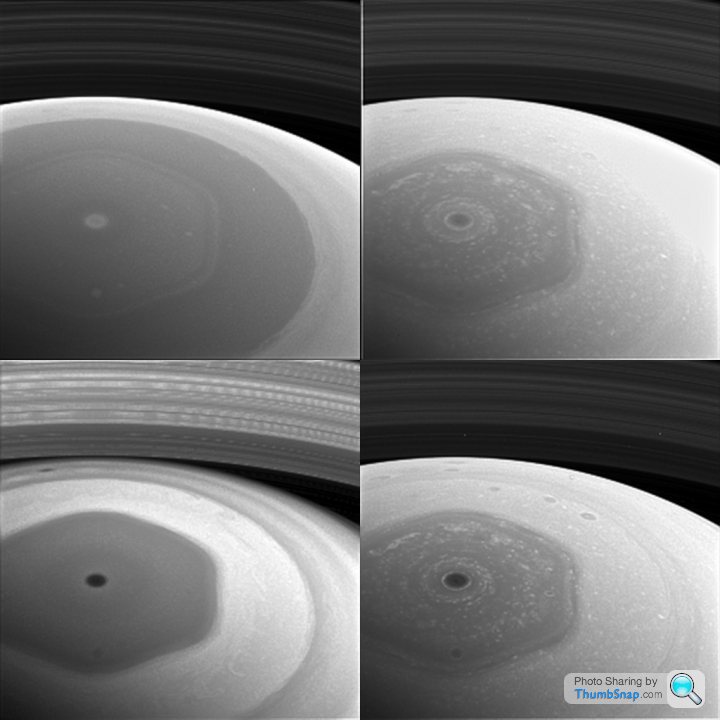Saturn images - Cassini
Discussion
That's one of the things they asked on the Stargazing Live programmes on BBC2 this week. The short version is that it is not dissimilar to our jetstream here on Earth.
http://www.jpl.nasa.gov/news/news.php?release=2013...
http://www.jpl.nasa.gov/news/news.php?release=2013...
You can also get them from here
http://ciclops.org/?js=1
Look through the imaging diary. Other older missions imagery is on the home page
http://ciclops.org/?js=1
Look through the imaging diary. Other older missions imagery is on the home page
Truly amazing!
What is just as amazing is the mathematics of getting that spacecraft into those positions, getting the cameras pointing the right way etc etc. Every moons position worked out years in advance, gravitational swings coordinated etc. There are some very, very clever people around. It's mind blowing.
What is just as amazing is the mathematics of getting that spacecraft into those positions, getting the cameras pointing the right way etc etc. Every moons position worked out years in advance, gravitational swings coordinated etc. There are some very, very clever people around. It's mind blowing.
Bumpity bump.
Cassini is coming to an end, it will plummet into Saturn in 2017.
https://saturn.jpl.nasa.gov/news/2974/cassini-make...
The grazing orbits here
https://saturn.jpl.nasa.gov/news/2966/ring-grazing...
Going to be interesting getting closer.
CreditsNASA from here link

Cassini is coming to an end, it will plummet into Saturn in 2017.
https://saturn.jpl.nasa.gov/news/2974/cassini-make...
The grazing orbits here
https://saturn.jpl.nasa.gov/news/2966/ring-grazing...
Going to be interesting getting closer.
CreditsNASA from here link

Fingers crossed for both these and the Finale orbits Inside the rings!
High potential for some amazing imagery and science... and a head on collision with a ring "particle" (I'd imagine anything more than a tiny pebble with shotgun Cassini into fragments)
What an amazing instrument its been! Some amazingly close flybys, still working 100% AFAIK.
High potential for some amazing imagery and science... and a head on collision with a ring "particle" (I'd imagine anything more than a tiny pebble with shotgun Cassini into fragments)
What an amazing instrument its been! Some amazingly close flybys, still working 100% AFAIK.
Yep, it is in the link.
"Clockwise from top left, the filters used are sensitive to violet (420 nanometers), red (648 nanometers), near-infrared (728 nanometers) and infrared (939 nanometers) light."
It is scary how little information is there compared to what could be achieved and yet it produces results.
Edit, just looked on here
https://eyes.nasa.gov/dsn/dsn.html
There are some margins in there that would scare the bejusus out of news truck operators with a 1.5 mtr dish......
"Clockwise from top left, the filters used are sensitive to violet (420 nanometers), red (648 nanometers), near-infrared (728 nanometers) and infrared (939 nanometers) light."
It is scary how little information is there compared to what could be achieved and yet it produces results.
Edit, just looked on here
https://eyes.nasa.gov/dsn/dsn.html
There are some margins in there that would scare the bejusus out of news truck operators with a 1.5 mtr dish......
Edited by jmorgan on Thursday 8th December 15:15
jmorgan said:
"Clockwise from top left, the filters used are sensitive to violet (420 nanometers), red (648 nanometers), near-infrared (728 nanometers) and infrared (939 nanometers) light."
It is scary how little information is there compared to what could be achieved and yet it produces results.
We have to remember Cassini was built in the 90's, designed in the 80's and uses space proven hardware, that means 60's/70's cutting edge technology for most things with a smattering of the best the 80's could offer, built and launched before the Internet, still going strong 20years later.It is scary how little information is there compared to what could be achieved and yet it produces results.
It's unfair to compare the imagery with what a 2016 digital camera could do... but given the humble chipset- albeit with staggeringly good optics and the worlds best photographers in control it is lights hours away and moving quickly yet they still take fuzz free sharp pictures.
Makes flying a Christmas present drone around the garden and moaning that the image isn't 4K a bit tame :-)
That is pretty normal for space technology. Contrary to what people sometimes think, space technology is rarely "cutting edge" in the sense of being right at the forefront of a given technology. Spacecraft need to be robust, reliable, hardened and maintenance free(in most cases).
So, designs tend to get frozen quite early on and, by the time the craft gets to fly, already a decade behind the latest capabilities.
So, designs tend to get frozen quite early on and, by the time the craft gets to fly, already a decade behind the latest capabilities.
Gassing Station | Science! | Top of Page | What's New | My Stuff






